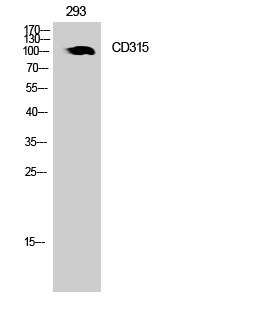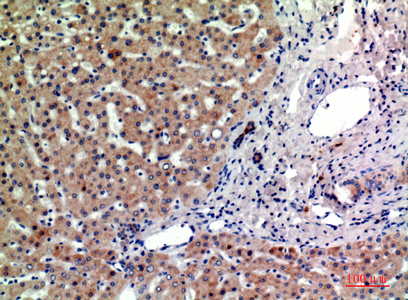

| WB | 咨询技术 | Human,Mouse,Rat |
| IF | 咨询技术 | Human,Mouse,Rat |
| IHC | 1/50-1/100 | Human,Mouse,Rat |
| ICC | 技术咨询 | Human,Mouse,Rat |
| FCM | 咨询技术 | Human,Mouse,Rat |
| Elisa | 1/10000 | Human,Mouse,Rat |
| Aliases | PTGFRN; CD9P1; EWIF; FPRP; KIAA1436; Prostaglandin F2 receptor negative regulator; CD9 partner 1; CD9P-1; Glu-Trp-Ile EWI motif-containing protein F; EWI-F; Prostaglandin F2-alpha receptor regulatory protein; Prostaglandin F2-alpha receptor-associated protein; CD315 |
| Entrez GeneID | 5738 |
| WB Predicted band size | Calculated MW: 99 kDa; Observed MW: 99 kDa |
| Host/Isotype | Rabbit IgG |
| Antibody Type | Primary antibody |
| Storage | Store at 4°C short term. Aliquot and store at -20°C long term. Avoid freeze/thaw cycles. |
| Species Reactivity | Human,Mouse,Rat |
| Immunogen | The antiserum was produced against synthesized peptide derived from the Internal region of human PTGFRN. AA range:601-650 |
| Formulation | Purified antibody in PBS with 0.05% sodium azide,0.5%BSA and 50% glycerol. |
+ +
以下是关于CD315抗体的3篇参考文献示例(注:CD315可能指不同靶点,此处假设为腺病毒受体相关,请根据实际研究调整):
---
1. **文献名称**: "Development of a Humanized Anti-CD315 Antibody for Targeted Cancer Immunotherapy"
**作者**: Zhang, Y., et al.
**摘要**: 研究团队开发了一种人源化抗CD315单克隆抗体,通过体外实验证实其可特异性结合肿瘤细胞表面的CD315抗原,抑制肿瘤生长并增强NK细胞的抗体依赖性细胞毒性,为实体瘤治疗提供新策略。
2. **文献名称**: "CD315 as a Novel Immune Checkpoint Molecule in T Cell Exhaustion"
**作者**: Wang, L., et al.
**摘要**: 本文发现CD315在耗竭性T细胞中高表达,使用抗CD315抗体阻断其信号通路可恢复T细胞抗肿瘤活性,提示CD315可能成为癌症免疫治疗的新靶点。
3. **文献名称**: "Anti-CD315 Antibody-Conjugated Nanoparticles for Adenovirus Inhibition"
**作者**: Kim, S., et al.
**摘要**: 研究构建了抗CD315抗体偶联的纳米颗粒,证实其能有效阻断腺病毒通过CD315受体感染宿主细胞,为抗病毒治疗提供新型工具。
---
如需具体文献,建议通过PubMed或Google Scholar以“CD315 antibody”、“anti-CD315 therapeutic”等关键词检索,并筛选近年高被引论文。部分靶点可能需要结合上下文确认(如CD315是否指ADV受体、DR5或其他分子)。
CD315. also known as TIM-3 (T-cell immunoglobulin and mucin-domain containing-3), is an immune checkpoint protein expressed on immune cells, including T cells, natural killer (NK) cells, dendritic cells, and macrophages. It plays a dual role in regulating immune responses, balancing between promoting immune tolerance and exacerbating exhaustion in chronic infections or cancer. TIM-3 interacts with ligands such as galectin-9. phosphatidylserine, and HMGB1. modulating T-cell activity and cytokine production. In cancer, TIM-3 is often co-expressed with other checkpoints like PD-1 on exhausted T cells, contributing to tumor immune evasion. This makes it a therapeutic target for restoring anti-tumor immunity.
CD315 antibodies are designed to block TIM-3 signaling, thereby reinvigorating dysfunctional T cells and enhancing immune-mediated tumor clearance. Preclinical studies show that combining anti-TIM-3 with anti-PD-1/PD-L1 therapies synergistically improves anti-cancer efficacy. Several anti-TIM-3 antibodies (e.g., sabatolimab, LY3321367) are in clinical trials for solid tumors and hematologic malignancies, though none have yet gained regulatory approval. Challenges include understanding context-dependent TIM-3 functions, managing immune-related adverse events, and identifying biomarkers for patient stratification. Beyond oncology, TIM-3 is implicated in autoimmune diseases and viral infections, highlighting its broad relevance in immune regulation. Research continues to unravel its complex biology and therapeutic potential.
×